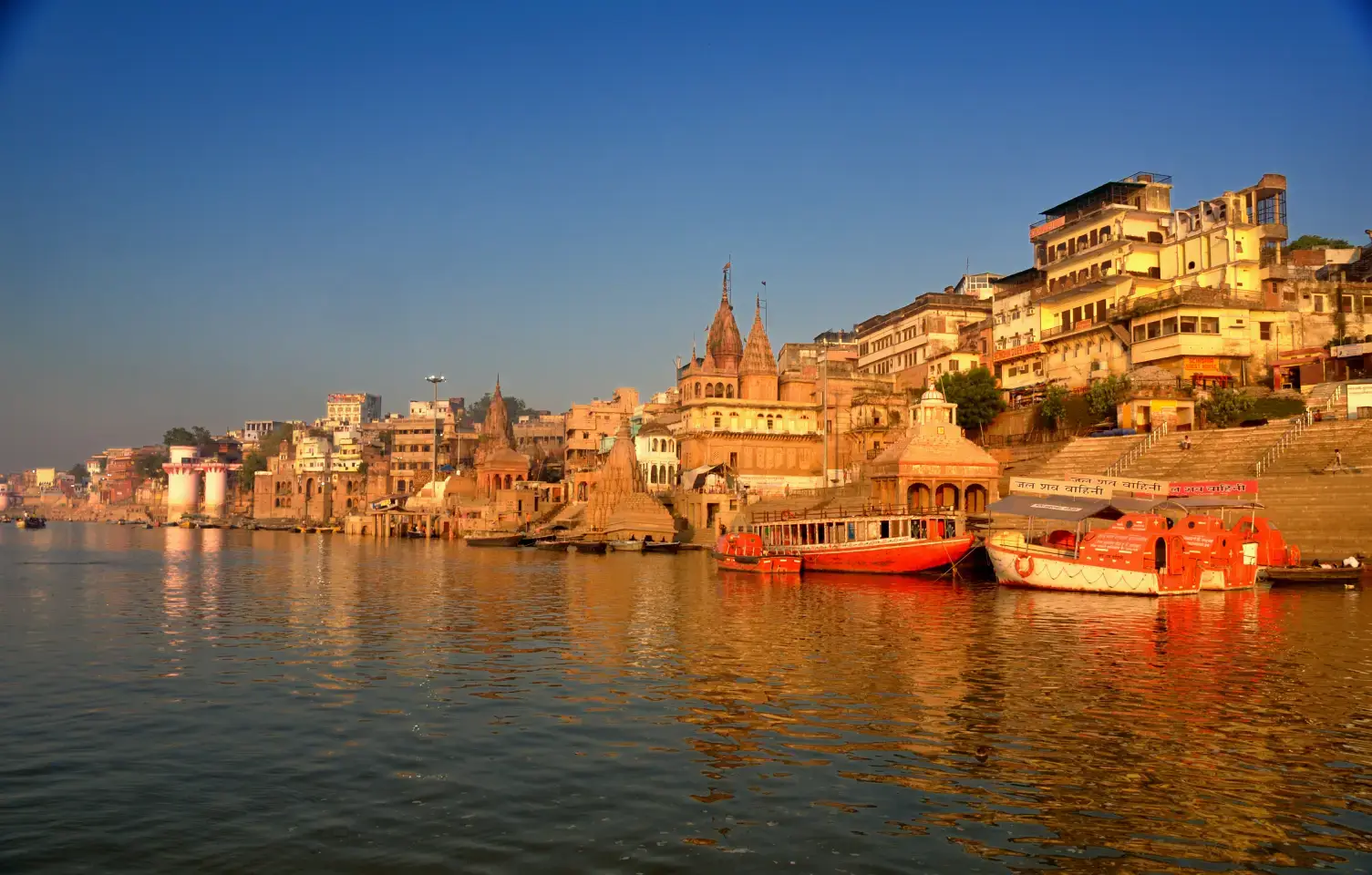

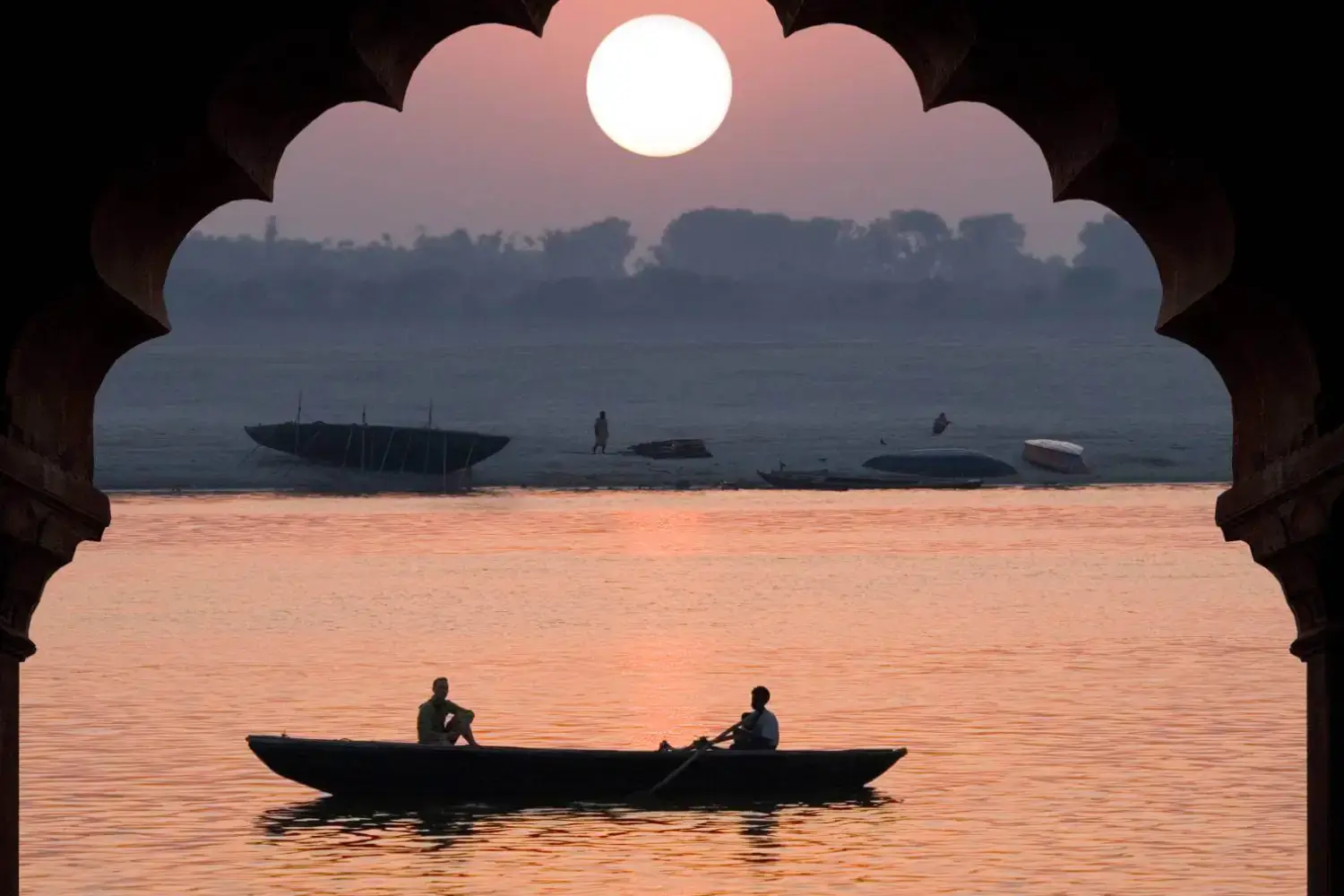
If you know India, you are bound to know the one Indian city that is the oldest in the history of civilization, Varanasi. Call it Varanasi, Banaras, or Kashi; this city oozes with once-in-a-lifetime experiences. Varanasi is known for its spiritual excellence, here you will find some of the most revered and historical temples of India, and it is also known for its cultural affluence, as it hosts jaw-dropping grand ceremonies that you cannot witness anywhere else in India. Besides, it is not just a place for religious significance but is a hub for academics, yoga, gastronomy, and spirituality.
This city of old age has evolved simultaneously with time; thus, it still looks like in its golden glory. So, now Varanasi is an amalgamation of the ancient and modern world. Like, you will still witness the Ganga Aarti ritual performed in an ancient way, but you can see it on big screens and watch it from ferries. The city has molded itself with modernity.
Varanasi is most popularized for its narrow and historic streets known as "Banaras Ki Galiyan". However, if you are planning your visit to Varanasi, Uttar Pradesh, you should know more than the narrow streets. You need to know the best places that should be visited to experience Varanasi thoroughly. This blog lists the top 10 places to visit in Varanasi, helping you make the most of your journey to Varanasi.
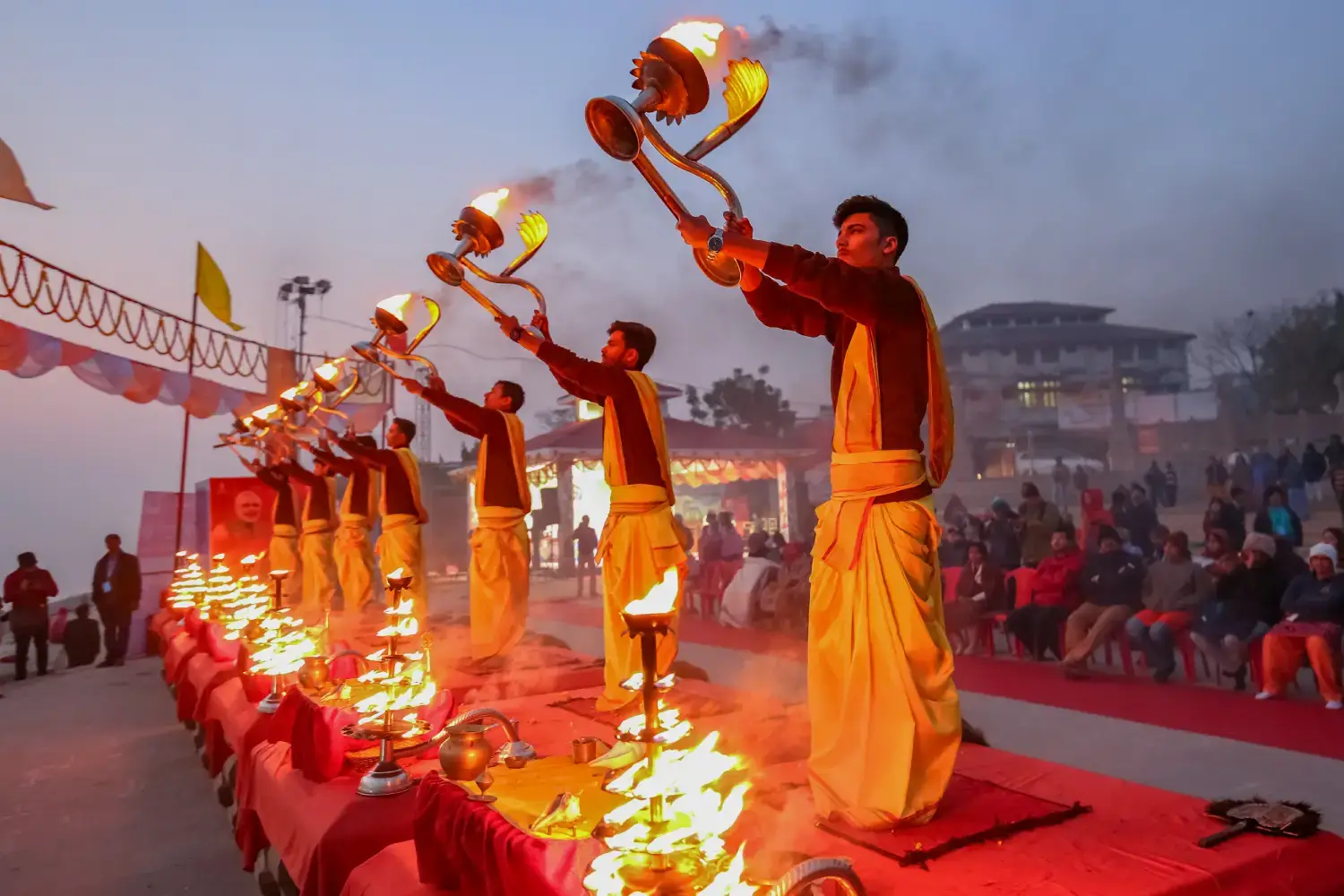

The significance of Kashi Vishwanath Mandir unveils just as you get to know that it is a 1000-year-old Shiv temple that has been destroyed not just a single time, but four times over the centuries, only to be rebuilt by devotees of Shiva every time. It sets an example of the unshakable devotion followers of Hindu Religion have towards their deities. Although there are many temples in Varanasi, none is akin to the glory of this Temple. It is constructed around a grandly architecture complex that houses not just the temple, but much more for the pilgrims. It has a museum, hospice for elderly devotees, storage facilities, stores to buy books and other sacred things, food court, and a stage for public programmes. Once you enter this big complex, you are in a spiritual world that amalgamates with your soul completely.
Kashi Vishwanath Temple is the most powerful among the 12 Jyotirlingas in Hindu religion. Even the temple is mentioned in Skanda Purana in its Kashi Khand. Banaras Kashi Vishwanath Temple is a place where you feel absolutely connected to Lord Shiva. People reach here every day in immense crowds, continuously chanting mantras with synchronous ringing of bells. Moreover, the architecture of the temple is notable. Although the whole complex was built just a few years back, the temples in it are significantly old. The main temple structure also has a plating of gold on its dome and spire. Throughout history, many rulers, kings, and devotees have contributed to the making of this temple. So, feel the history sipping through every corner of Kashi Vishwanath Temple by yourself.
Pro Tip : You are not allowed to take anything inside the temple, However, there are free lockers available inside the complex but only to keep mobile phones

Home of ancient royal families of Varanasi, Ramnagar Fort, is a magnificent site to visit in your Varanasi tour. It is present on the eastern bank, opposite side of all major Ghats, of the Ganga River. Once the fort used to be a residence of Maharajas of Banaras, now it is majorly a tourist attraction that sings the tale of centuries old. However, a small portion of Ramnagar Fort is still used by the Royal family, most of it has been turned into a museum. It houses ancient scriptures and scripts, vintage furniture, costumes, and precious metal articles. There is also an armory section that contains guns and swords from different countries including Japan and Myanmar
The Ramnagar fort is located at the southern edge of Varanasi and, thus is a little far from famous ghats. You can either take a boat ride or cross the Ramnagar bridge to reach the fort. The incredible fort is located beside the Ganga River thus giving a more jaw-dropping view from the back side. The Fort also has a few temples inside its boundaries including Ved Vyas temple and a Hanuman Temple. These temples are popular sites inside the fort and something you should not miss to see.
Pro Tip : While the fort is open year-round, the best time to visit is during the cooler months, from October to March. This will not only make your exploration more comfortable but also coincide with the possibility of experiencing the spectacular Ramlila festival held there.

Durga temple stands out in the landscape due to its dark red color and multi-tiered shikhara, capturing everyone's eye. The red color of this temple signifies the qualities of the goddess Durga, which are power and strength. The complex looks complete with its ancient Durga Kund, a water pond that got water directly from the Ganga River earlier. You will be accompanied by the smooth dodge and weaves of monkeys. The dense population of monkeys is the reason this temple is also known as Monkey Temple.
Durga Temple was built in the 18th century by a queen of Bengal to make it a center for worshipping Devi Durga in Varanasi. And the idea met destiny, as it is now one of the most popular Durga temples in Varanasi. The idol in this temple is believed not to be placed by any human but emerged on its own. Thus, worshiping in this unique temple is believed to protect devotees from all problems. Durga Temple also has many engraved and carved stones inside the temple from old centuries. Pilgrims continuously can be seen praying and chanting in this temple, which creates an extremely beautiful aura of calmness in this spiritual destination.
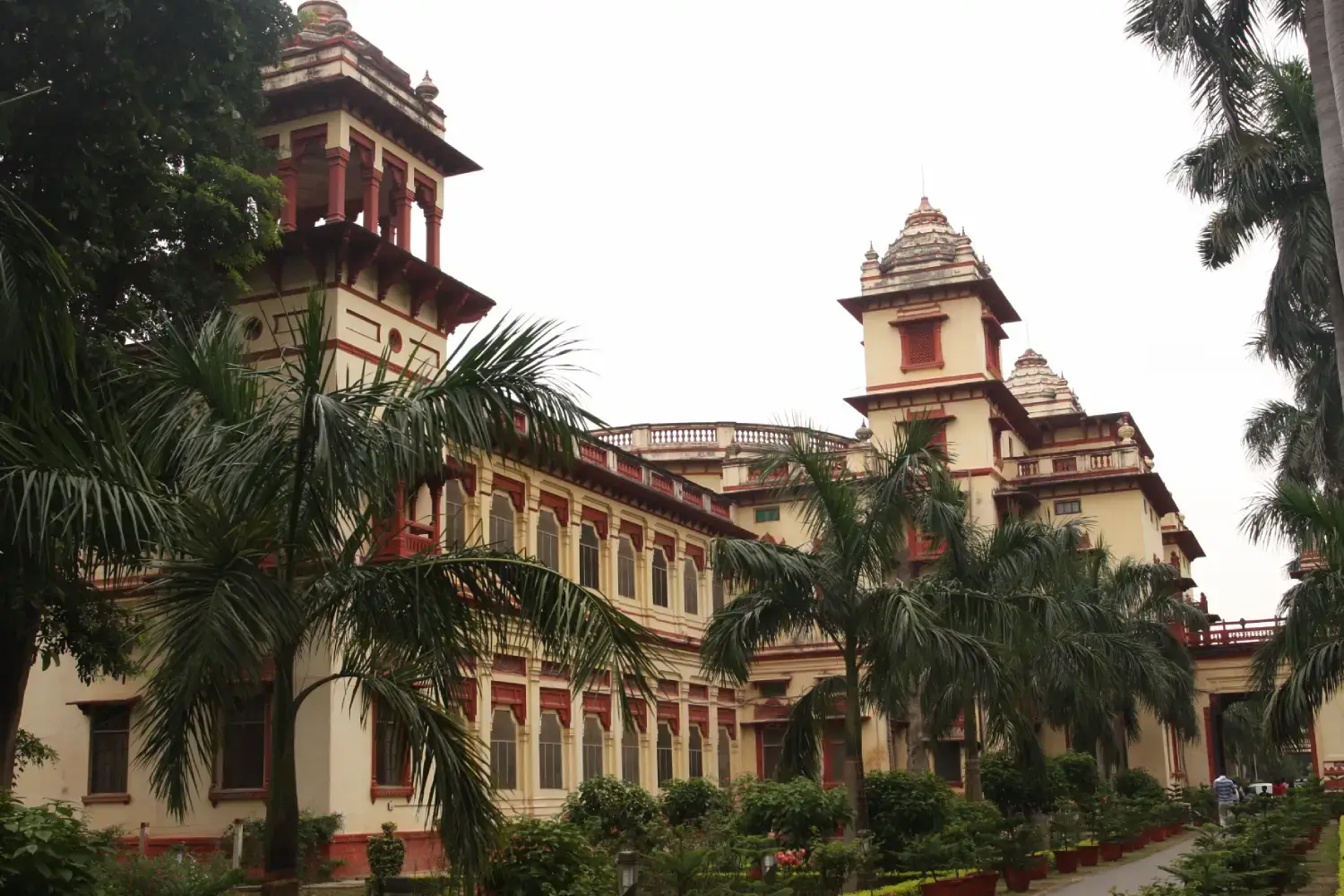
The only place away from the busy Banaras crowd, Hindu University, is a big institutional campus that it would not be wrong to refer it as a city inside a city. Although a university, it is a popular tourist attraction to explore among tourists in Varanasi. You can spend some time in quiet gardens or savoring different dishes in the food stalls. Not just that, BHU has Temples, a hospital, a library, and a museum inside the complex. The university itself is spread over around 1300 acres of land.
Banaras Hindu University is designed in a semi-circular way and one needs to take transportation to get around inside the campus itself. BHU is a lot calmer and has cleaner space, broader roads, and a beautifully paved pedestrian path. The whole area is surrounded by lush greenery and makes you feel like you are in a whole different world.
BHU has many different buildings, but each and every corner has an incredible architecture. It is beautifully built in the Indian-Gothic style of architecture. Banaras Hindu University has a museum named Bharat Kala Bhawan that has many articles related to textiles and old artifacts from Banaras. BHU has given many brilliant minds to the nation including some scientists, scholars, and artists. It is one of the biggest learning centers in the county and one of the major attractions in Varanasi
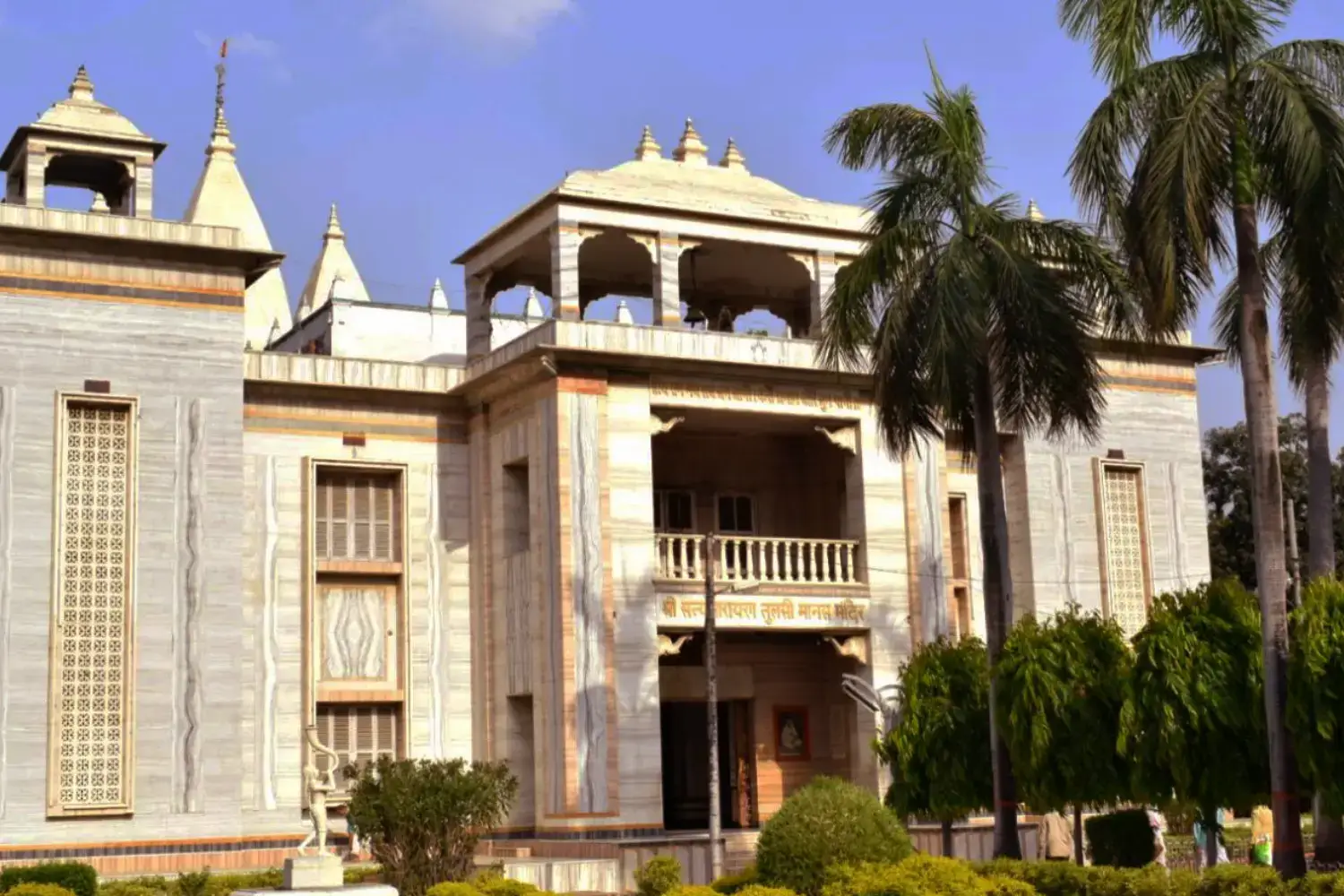
A temple which is built on the same place where the famous ancient poem Ramcharitmanas was written by Tulsidas. Ramcharitmas is an epic poem that explains the story of Lord Ram in a poetic way. Tulsi Manas Temple celebrates the glorious journey of Lord Ram, the righteous ruler of Ayodhya. The temple is entirely made of pearly white marble and perfectly comes to light after crossing the beautiful lush garden in front.
Tulsi Manas Temple has mesmerizing architecture with detailed work on every corner of the structure. However, the carvings and murals on the inner walls attract tourists the most. These carvings depict various moments of Lord Ram's life. However, these carvings are present everywhere in the temple.
Tulsi Manas temple is one of the most revered sites in Varanasi and it symbolizes the simplicity and grace of Hindu religion. Also, puppet shows are organized during festivals narrating the legend of Lord Ram. This Temple also has a museum with exhibits explaining Ramayan.

Varanasi is a place of religious getaway, but among all those religious destinations dedicated to some Hindu deity, there is a temple that has a whole different story. India has always been a place of country-lovers. Bharat Mata Temple is a sanctum that signifies the patriotism of Indians towards their nation. In this temple, Indians worship their country as a human manifestation of their country as Bharat Mata (Mother India). Unlike the other temples that have an idol of a deity, Bharat Mata Temple has a carved-out map of India on white marble.
This temple was built by an Indian freedom fighter, Babu Shiv Prashad Gupta, in the year 1936. The temple was inaugurated by Mahatma Gandhi. Bharat Mata temple's architecture is also quite unique and interesting. It is supported by five pillars which signify five aspects of nature - earth, wind, water, fire, and sky. This pentagon-shaped edifice is a symbol of patriotism thus visited by many people throughout the year. Bharat Mata Temple is one of the most visited tourist attractions in Varanasi. Experience the unique beliefs of the people of India in this temple. Moreover, the temple receives a lot of tourists on Indian Independence Day (15 August) and Indian Republic Day (26 January).
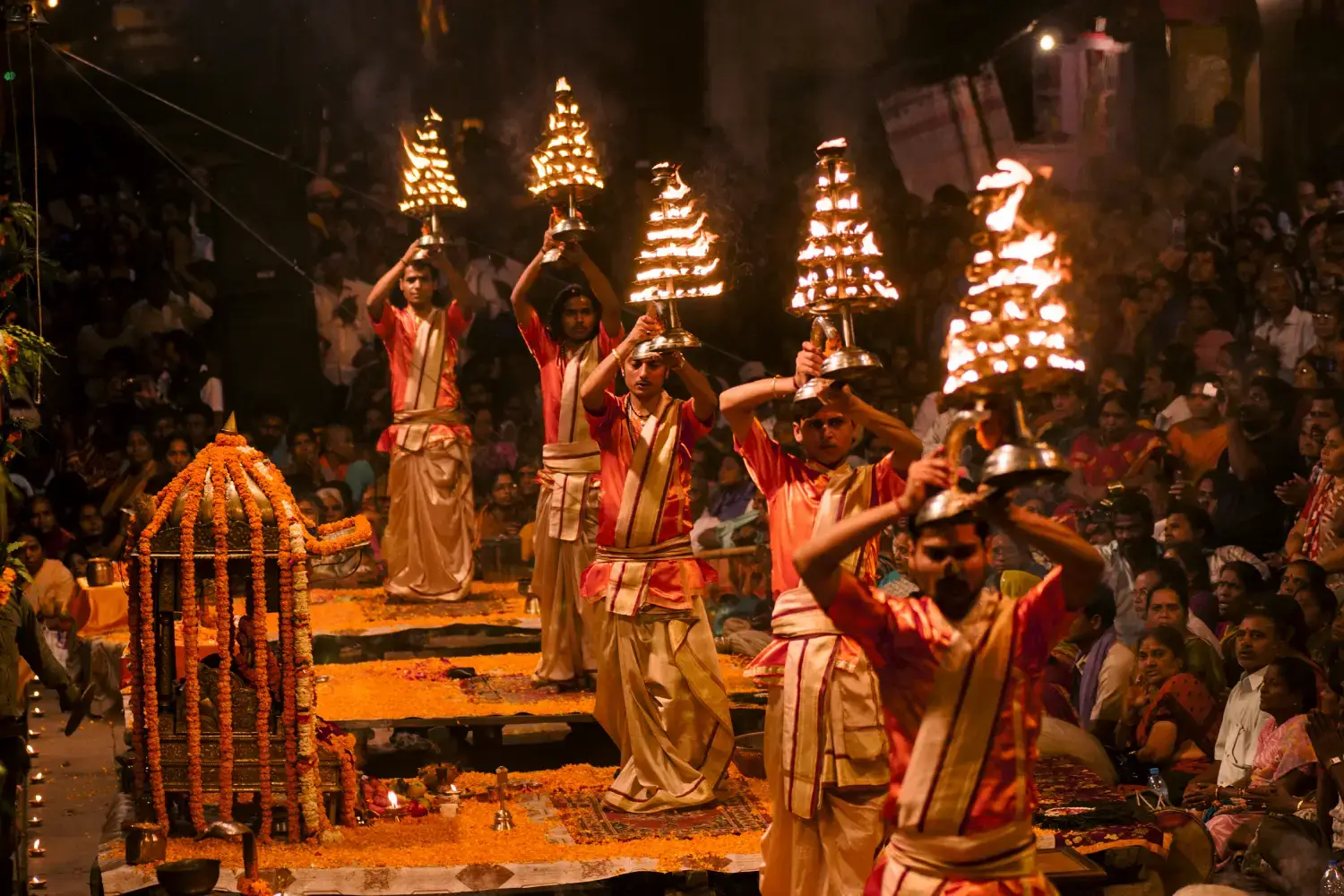
If you want to explore the liveliest place in Varanasi, Dashashwamedh Ghat is your place. This is the oldest Ghat in Varanasi and is visited by much more tourists than any other attraction in the city. It is its grand appearance and festive environment that draws much of the attention on this ghat. Still, Dashashwamedh Ghat is most famous for hosting the biggest and most splendid Ganga Aarti. When the sunlight fades away in the dusk, people start gathering in counts of thousands on Dashshwamedh Ghat to witness the mesmerising Ganga Aarti.
This ceremony is performed by priests wearing similar clothing, Kurta and Dhoti, who stand on a platform beside the river. The sound of conch shells blowing, ringing bells, and brass cymbals clinging is backed by chanting mantras in chorus. The priests, holding a lighted brass lamp of a shape akin to shikhara, perform synchronized wavy movements with hands and body that look unbelievably magnificent, and drag away any distraction while drawing your attention to the ritual. You can watch the Ganga aarti from the Ghat or from boats moored at the river bank.
Besides the unequivocally resplendent Ganga Aarti, Dashashwamedh Ghat is also a perfect spot for solitary lovers. Rows of boats aligned, vendors selling flowers and souvenirs, priests performing rituals for pilgrims on the steps, while tourists snapping photographs to capture the scene, is a normal day in Dashashwamedh Ghat. It is real peace to sit on this ghat to linger, observing people and the flowing river stream. So, don't miss the chance to not just explore the ghat but spend some time here having tea and doing nothing.
Pro Tip : If you want to see the Ganga Arti, you have to reach the ghats about an hour before to secure a place, Assi is still fine, but Dasashwanedha will be very difficult, people start gathering 2 hours before.
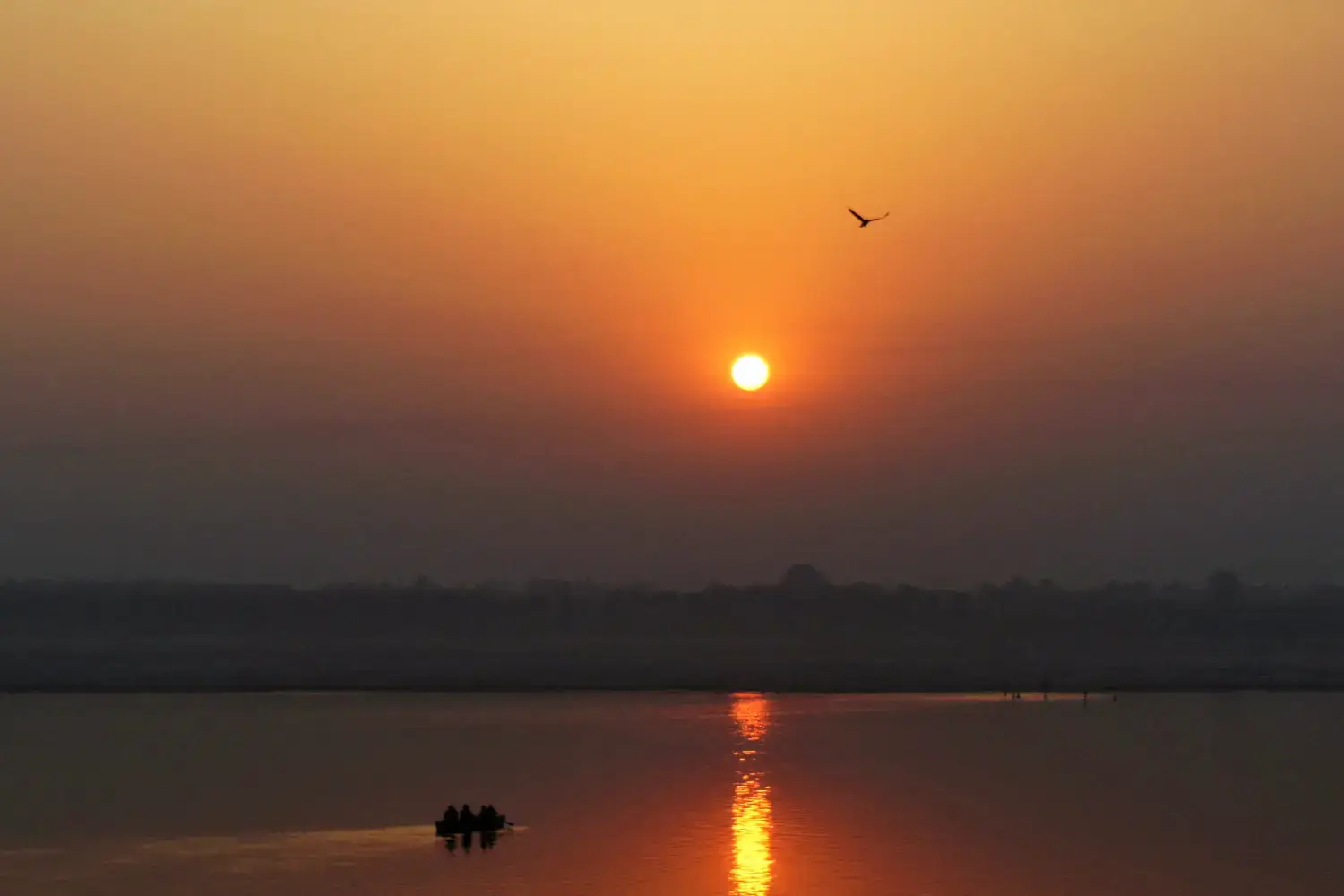
Assi Ghat is the southernmost riverside ghat at the Ganga River in Banaras. It is one of the most popular ghats in the city of Varanasi and stays filled with devotees and tourists at all times. Assi Ghat is located at the confluence of the Ganga and Assi Rivers (extinct river). The ghat is also a revered site in the Hindu religion, and according to mythology, Devi Durga killed her nemesis asur named Shumbha - Nishumbha here and threw her sword into River Assi. Another legend tells the story when Lord Shiva killed 80 asur (demons) on this ghat, but felt remorse later. Thus, Shiva declared Banaras a place that would stand as a symbol of peace.
People start coming to Assi Ghat as early as twilight when the sky starts coloring blue at 4 am. From then on, the ghat does not get clear of tourists any time. you can even spot a few people on the ghat even in the night-time. However, Assi Ghat turns substantially alive every evening. The concreted area fills up with hawkers and different artists performing or selling their art. Nevertheless, the time of evening Ganga Aarti is the best to be present at the Ghat or you will be missing the best spectacle.
Assi Ghat is also one of the most popular destinations in Varanasi as a starting point for boat rides. You can take a boat ride of the whole Varanasi river stretch or you can get to the other side of the river. On the opposite riverside of Assi Ghat is a long enough stretch of sand-beach where you can take a camel or horse rides. Photogenic people can take spectacular photographs here. Yet another adventure at Assia Ghat is the Hot air balloon ride, which gives you a mesmerizing view of old Banaras town beside the sacred river Ganga. There is much more to the Assi Ghat like the nearby temples with interesting legends, yoga and music at sunrise, interesting history, and much more which awaits your visit.
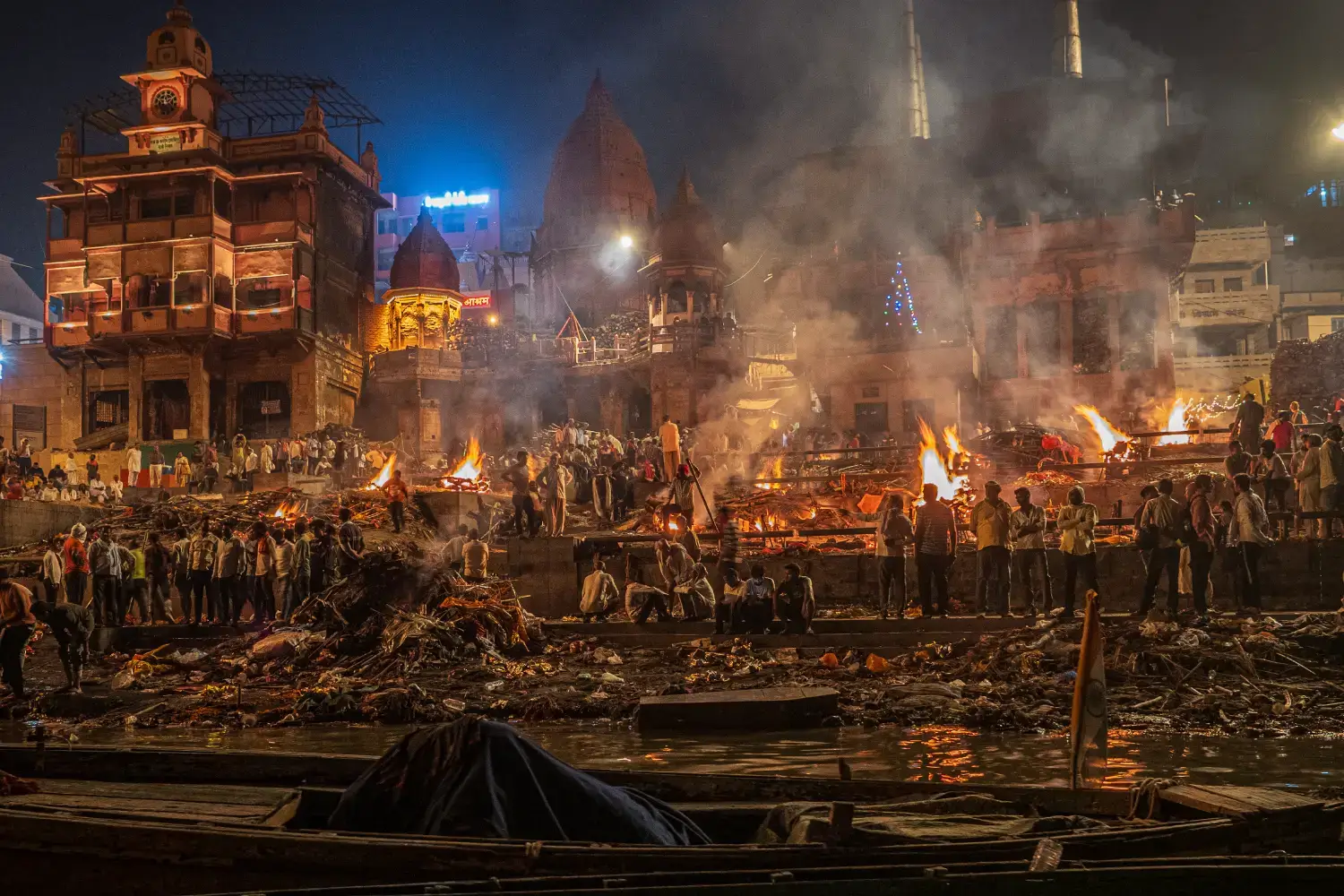
While most ghats in Varanasi give a sense of peace of mind and the soul, Manikarnika Ghat awakens people's psychology and reminds them about the fragility of life. This ghat has been used for centuries for performing cremation rites by Hindus, but people also come here to sit and think about the ultimate truth, the finality of life. People from all around the country are cremated on this ghat due to a strong belief in Hinduism, that, whoever is cremated here attains Moksha (salvation) right away.
The ghat was earlier named Chakrapushkarni Ghat because of a water pool there named Chakrapushkarni Kund. And there are two popular stories for its name. One related to Lord Vishnu and the other to Lord Shiva. In the first story, Lord Vishnu created this pond with his Chakra while doing tapasya, and in the second story, Maa Parvati dropped a precious stone (mani) from her earring at this very ghat.
Manikarnika Ghat is a significant destination from both religious and cultural standpoints. While the southern side of this Ghat is used for cremation, the northern side is clean and used by devotees for taking sacred baths and performing rituals before cremating their deceased relative. Also, many Hindus visit Manikarnika Ghat on various festive occasions throughout the year including in Ekadashi, surya-chandra grahan, Sankranti, and the month of Kārtika.
After the establishment of now now-present ghat in 1730, Many temples and religious sanctums were built on and around the ghat. Various temples dedicated to different Hindu deities like Uma, Ganesh, Pitamah, Indreshwar, Vishnu, and Skanda are present at the Ghat, but the majority of the temples are dedicated to Lord Shiv.
Pro Tip : Make sure to try the special lassi which are available near Manikarnika Ghat. These special lassis are topped with malai and rabdi, making it a delicious dessert.

Sankat Mochan, which means annihilator of problems, is a temple dedicated to one of the most strengthful deities in Hinduism - Lord Hanuman. Worshipping in this temple is said to eradicate any problems coming your way attaining a goal. Devotees offer a special sweet named Besan Ka Laddu and a marigold flower garland to God Hanuman, especially on Tuesdays and Saturdays. These two days are believed to be the days of Hanuman thus, every week, receive double crowd than any other day.
Sankat Mochan Temple is an old Hindu temple and its establishment is associated with sage Tulsidas. It is believed that Tulsidas saw Lord Hanuman in this place and decided to dedicate a temple at the exact same location. This temple is just 5 minutes away from Durga Temple and 10 minutes from Banaras Ganga Ghats.
Pro Tip : Temple doesn't allow bags, cameras, and mobile phones inside. You can put your belongings in the lockers in the temple. However, wallets are allowed inside the temple.